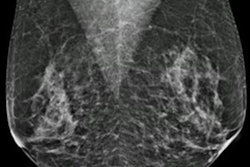
Starting use of combined oral hormonal contraceptives may prompt an initial increase in mammographic breast density, but the effect doesn't persist, suggests a study published March 6 in Clinical Imaging.
Researchers led by Dr. Jonathan Hunt from the Women's Health Institute in Cleveland found that long-term use of combined oral contraceptives or a levonorgestrel intrauterine device (IUD) -- as well as discontinuing use of combined oral contraceptives -- are not associated with an increase in women's breast density category.
"These findings should not impact reading and interpretation of mammograms of women taking hormonal contraceptives but may be important when clinicians counsel patients on how hormonal contraceptive use or changes impact mammographic parameters such as density," Hunt told AuntMinnie.com.
Previous research suggests that breast density -- an independent risk factor for breast cancer due to mammography's limitations for detecting cancers in dense tissue -- is impacted by exogenous hormones, such as from contraceptives. However, the researchers noted that there is limited data on time-related effects of such hormonal contraception on mammographic density in women of reproductive age.
Hunt and colleagues explored potential longitudinal relationships between mammographic density and hormonal contraceptive use in women ages 35 to 50. The 708 randomly selected women underwent five or more screening mammograms within a 7.5-year period between 2004 and 2019. From there, they were placed into one of four different cohorts based on hormonal contraceptive exposure.
The cohorts included the following: never exposed, always exposed, interval hormonal contraceptive start, and interval hormonal contraceptive stop. The researchers assessed differences in BI-RADS breast density category between initial and final mammograms.
They found that while starting combined oral contraceptives led to a significant increase in BI-RADS density category, starting use of an IUD led to a decrease in category. They also reported no significant differences in initial breast density in patients exposed to combined oral contraceptives over the lead-in period versus those not exposed.
| BI-RADS density category changes in women exposed and not exposed to combined oral contraceptives, IUD | ||||||
| Factor | Never exposed | Combined oral contraceptives | IUD | |||
| Always exposed | Interval start | Interval stop | Always exposed | Interval start | ||
| Initial BI-RADS density category | 2.6 | 2.7 | 2.5 | 2.7 | 3.0 | 3.1 |
| Final BI-RADS density category | 2.7 | 2.7 | 2.8 | 2.6 | 2.7 | 3.1 |
The researchers wrote that the increase in BI-RADS breast density category in the contraceptive interval start cohort was statistically significant compared to the never exposed cohort (p = 0.045), but Hunt noted that this finding could be "transient."
He explained that there was no difference in the initial breast density categories between the "always exposed" and "never exposed" cohorts following the two-year lead-in period.
As for the IUD findings, the study authors suggested that a clinically meaningful impact of IUDs on breast density would be surprising, noting that the highest dose of 52 mg of contraceptive from IUDs produces only about a 20th of systemic progestin exposure compared to a typical oral contraceptive; other IUD formulations having even less systemic absorption.
Future research is needed to clarify these findings by dose and progestin type and to show whether breast density does return to baseline with longer follow-up after a new initiation of combined oral contraceptives, Hunt told AuntMinnie.com.




















